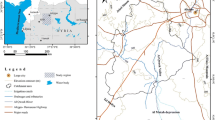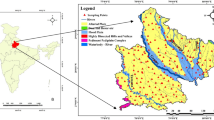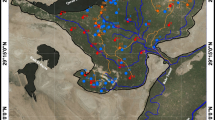Abstract
The present study was carried out in Meki River Basin (Ethiopian Rift) aiming at characterizing the hydrochemical composition of groundwater and evaluating the water quality status for drinking and irrigation uses. For this purpose, 63 primary groundwater samples from springs, hand-dug wells, and boreholes were collected and subjected to major ions analysis besides the in situ tests. The analysis result illustrates that Na+ and HCO3− are the principal cation and anion in the study area. The spatial investigation of the physiochemical parameters revealed that temperature, pH, TDS, EC, Na+, K+, HCO3−, Cl−, SO42−, and F− show a positive trend from the highland towards the rift floor along the groundwater flow direction. On the contrary, Ca2+ and Mg2+ show a negative tendency along the groundwater flow path. The groundwater of the study area generally evolves from predominantly fresh (TDS < 200 mg/l) Ca/Mg–HCO3 water type in the upland area to moderate TDS (200–750 mg/l) Na/Ca–HCO3 water type in the transitional escarpment and lastly to dominantly mineralized (TDS > 750 mg/l) Na–HCO3 water type in the rift floor following the regional groundwater flow path. Gibbs diagram supported by ionic ratio (Na+ + K+/Ca2+ + Mg2+ vs total cations (TZ+) and Chloro-Alkaline Indices (CAIs) suggests that rock–water interaction (silicate hydrolysis and cation exchange) is the major hydrochemical processes controlling the evolution of the groundwater in the study area. 19% of TDS, 11% of EC, 83% of K+, 84% of HCO3−, and 52% of F− of the total water samples were unsuitable for the drinking uses compared with WHO water quality guideline. Spatial distribution maps of major ions (Ca2+, Mg2+, Na+, K+, Cl−, HCO3−, SO42−, and F−) and binary plots of physical parameters (temperature, pH, TDS, and EC) with elevation were produced. Both the spatial maps and binary plots generally show a water quality drop rift wards. Similarly, using multiple agriculture water quality criteria such as EC, SAR, RSC, PI, and Na%, the suitability of the groundwater for agricultural use was evaluated. Except a few samples in the rift floor, the majority of the water samples are found to be suitable for irrigation uses. As the study area is located where active geothermal activity and fluid circulation through fault systems, it is highly advised to carry out further toxic trace elements analysis to investigate the possible influence on the water quality.













Similar content being viewed by others
References
Alemayehu T (2006) Groundwater occurrence in Ethiopia. Addis Ababa University, Addis Ababa, p 88
APHA (2005) Standard methods for the examination of water and wastewater, 21st edn. American Public Health Association, Washington
Arveti N, Sarma MRS, Aitkenhead-Peterson JA, Sunil K (2011) Fluoride incidence in groundwater: a case study from Talupula, Andhra Pradesh, India. Environ Monit Asses 172:427–443
Awaleh MO, Baudron P, Soubaneh YD, Boschetti T, Hoch FB, Egueh NM, Gassani J (2017) Recharge, groundwater flow pattern and contamination processes in an arid volcanic area: insights from isotopic and geochemical tracers (Bara aquifer system, Republic of Djibouti). J Geochem Explor 175:82–98. https://doi.org/10.1016/j.gexplo.2017.01.005
Awaleh MO, Boschetti T, Adaneh AE, Daoud MA, Ahmed MM, Dabar OA, Kadieh IH (2020) Hydrochemistry and multi-isotope study of the waters from Hanlé-Gaggadé grabens (Republic of Djibouti, East African Rift System): a low-enthalpy geothermal resource from a transboundary aquifer. Geothermics 86:101805. https://doi.org/10.1016/j.geothermics.2020.101805
Awaleh MO, Hoch FB, Boschetti T, Soubaneh YD, Egueh NM, Elmi SA, Khaireh MA (2015) The geothermal resources of the Republic of Djibouti—II: geochemical study of the Lake Abhe geothermal field. J Geochem Explor 159:129–147. https://doi.org/10.1016/j.gexplo.2015.08.011
Awaleh MO, Boschetti T, Soubaneh YD, Baudron P, Kawalieh AD, Dabar OA, Ahmed MM, Ahmed SI, Daoud MA, Egueh NM, Jalludin M (2016) Geochemical study of the Sakalol-Harralol geothermal field (Republic of Djibouti): evidences of a low enthalpy aquifer between Manda-Inakir and Asal rift settings. J Volcanol Geotherm Res. https://doi.org/10.1016/j.jvolgeores.2016.11.008
Ayenew T (2008) The distribution and hydrogeological controls of fluoride in the groundwater of Central Ethiopian Rift and adjacent highlands. Environ Geol 54:1313–1324
Ayenew T (2005) Major ions composition of the groundwater and surface water systems and their geological and geochemical controls in the Ethiopian volcanic terrain. SINET Ethiop J Sci 28(2):171–188
Ayenew T (2001) Numerical groundwater flow modeling of the central Main Ethiopian Rift lakes basin. SINET Ethiop J Sci 24(2):167–184
Ayenew T (1998) The hydrogeological system of the Lake District Basin, Central Main Ethiopian Rift. Ph.D. Thesis, Free University of Amsterdam, The Netherlands
Ayenew T, Fikre S, Wisotzky F, Demlie M, Wohnlich S (2009) Hierarchical cluster analysis of Hydrochemical data as a tool for assessing the evolution and dynamics of groundwater across the Ethiopian rift. Int J Phys Sci 4(2):076–090
Barzegar R, Moghaddam AA, Tziritis E, Fakhri MS, Soltani S (2017) Identification of hydrogeochemical processes and pollution sources of groundwater resources in the Marand plain, northwest of Iran. Environ Earth Sci 76:297. https://doi.org/10.1007/s12665-017-6612-y
Benvenuti M, Carnicelli S, Belluomini G, Dainelli N, Grazia SD, Ferrari GA, Iasio C, Sagri M, Ventra D, Balemwald A, Kebede S (2002) The Ziway–Shala lake basin (main Ethiopian rift, Ethiopia): a revision of basin evolution with special reference to the late Quaternary. J Afr Earth Sci 35:247–269
Bhunia GS, Keshavarzi A, Shit PK, Omran EE, Bagherzadeh A (2018) Evaluation of groundwater quality and its suitability for drinking and irrigation using GIS and geostatistics techniques in semiarid region of Neyshabu, Iran. Appl Water Sci 8:168. https://doi.org/10.1007/s13201-018-0795-6
Boccaletti M, Bonini M, Mazzuoli R, Abebe B, Piccardi L, Tortorici L (1998) Quaternary oblique extensional tectonics in the Ethiopian Rift (Horn of Africa). Tectonophysics 287:97–116. https://doi.org/10.1016/S00401951(98)80063-2
Brindha K, Jagadeshan G, Kalpana L, Elango L (2016) Fluoride in weathered rock aquifers of southern India: managed aquifer recharge for mitigation. Environ Sci Pollut Res 23:8302–8316
Chernet T (1982) Hydrogeology of the Lakes Region. Ethiopia, Ministry of Mines and Energy, Addis Ababa
Chernet T, Travi Y, Valles V (2001) Mechanism of degradation of the quality of natural water in the lakes region of the Ethiopian rift valley. Water Res 35:2819–2832
Collet C (1996) Geographic information system needs and software in geographical information systems in hydrology, 1st edn. Kluwer Academic Publishers, Boston
Dainelli N, Benvenuti M, Sagri M (2001) Geological map of the Ziway–Shala lakes basin (Ethiopia). 1:250000. Italian Ministry for University and Scientific and Technological Research (MURST)
Darling WG (1996) The geochemistry of fluid processes in the eastern branch of the East African rift system. Ph.D. Thesis, Open University, Milton Keynes, UK
Deshpande SM, Aher KR (2012) Evaluation of groundwater quality and its suitability for drinking and agriculture use in parts of Vaijapur, District Aurangabad, MS, India. Res J Chem Sci 2(1):25–31
Doneen LD (1964) Notes on water quality in Agriculture Published as a Water Science and Engineering Paper 4001, Department of Water Science and Engineering, University of California
Eaton EM (1950) Significance of carbonate in irrigation water. Soil Sci 69:123–133
ESRI (2004) Using ArcGIS geostatistical analyst. Redlands, Environmental Systems Research Institute, p 300
Farooq G, Ustad I (2015) Investigation of physico-chemical properties of groundwater from commercial boreholes in Altamash Colony, Aurangabad. World J Pharm Pharm Sci 4:1625–1630
Freeze RA, Cherry JA (1979) Ground water. Prentice-Hall, Inc., New Jersey
Furi W, Razack M, Abiye TA, Ayenew T, Legesse D (2011) Fluoride enrichment mechanism and geospatial distribution in the volcanic aquifers of the Middle Awash basin, Northern Main Ethiopian rift. J Afr Earth Sci 60:315–327
Gashaw H (1999) Hydrochemistry of waters in Ziway lake area. Integrated development for water supply and sanitation. In: 25th WEDC conference. Addis Ababa, Ethiopia
Gibbs RJ (1970) Mechanisms controlling world water chemistry. Science 17:1088–1090. https://doi.org/10.1126/science.170.3962.1088
Gizaw B (1996) The origin of high bicarbonate and fluoride concentrations in waters of the Main Ethiopian Rift Valley, East African Rift system. J Afr Earth Sci 2:39–402
Halcrow MA (2008) Rift valley lakes integrated natural resources development master plan Ethiopian valleys development studies authorities. Ministry of Water Resources, Addis Ababa
Hallouche B, Marok A, Benaabidate L, Berrahal Y, Hadji F (2017) Geochemical and qualitative assessment of groundwater of the High Mekerra watershed, NW Algeria. Environ Earth Sci 76:340. https://doi.org/10.1007/s12665-017-6649-y
Jalali M (2011) Hydrogeochemistry of groundwater and its suitability for drinking and agricultural use in Nahavand, Western Iran. Nat Resour Res 20:1. https://doi.org/10.1007/s11053-010-9131-z
Kaka EA, Akiti TT, Nartey VK, Bam EKP, Adomako D (2011) Hydrochemistry and evaluation of groundwater suitability for irrigation and drinking purposes in the southeastern Volta river basin: manya krobo area, Ghana. Elixir Agric 39:4793–4807
Kangaraj G, Elango L (2016) Hydrogeochemical processes and impact of tanning industries on groundwater quality in Ambur, Vellore district, Tamil Nadu, India. Environ Sci Pollut Res 23(23):24364–24383. https://doi.org/10.1007/s11356-016-7639-4
Kawo NS, Karuppannan S (2018) Groundwater quality assessment using water quality index and GIS technique in Modjo River Basin, central Ethiopia. J Afr Earth Sci 147:300–311. https://doi.org/10.1016/j.jafrearsci.2018.06.034
Kebede S, Travi Y, Asrat A, Alemayehu T, Ayenew T, Tessema Z (2008) Groundwater origin and flow along selected transects in Ethiopian rift volcanic aquifers. Hydrogeol J 16(1):55–73. https://doi.org/10.1007/s10040-007-0210-0
Kebede S, Travi Y, Stadler S (2010) Groundwaters of the Central Ethiopian Rift: diagnostic trends in trace elements, 18O and major elements. Environ Earth Sci 61:1641–1655
Kebede S (2013) Groundwater in Ethiopia—features, numbers and opportunities. Springer, Berlin. https://www.springer.com/gp/book/9783642303906
Kim K, Rajmohan N, Kim HJ, Kim SH, Hwang GS, Yun ST, Gu B, Cho MJ, Lee SH (2005) Evaluation of geochemical processes affecting groundwater chemistry based on mass balance approach: a case study in Namwon, Korea. Geochem J 39:357–369
Kumar M, Kumari K, Ramanathan AL, Saxena R (2007) A comparative evaluation of groundwater suitability for irrigation and drinking purposes in two agriculture dominated districts of Punjab, India. J Environ Geol 53:553–574
Kundo C (1975) Hydrogeological studies on the thermal springs of Ethiopia. Mem Fac Educ Akita Univ 25:21–54
Le Turdu C, Tiercelin JJ, Gibert E, Travi Y, Lezzar K, Richert J, Massault M, Gasse F, Bonnefille R, Decobert M, Gensous B, Jeudy V, Tamrat E, Mohamed MU, Martens K, Balemwal A, Chernet T, Williamson D, Taieb M (1999) The Ziway-Shala lake basin system, Main Ethiopian Rift: influence of volcanism, tectonics, and climatic forcing on basin formation and sedimentation. Paleogeogr Paleoclimatol Paleoecol 150:135–177
Lo CP, Yeung AK (2003) Concepts and techniques of geographic information systems. New Delhi, Prentice-Hall of India Pvt. Ltd, p 492
Mackenzie FJ, Garrells RH (1965) Silicates: reactivity with water. Sci J 1505:57–58
Mechal A, Birk S, Dietzel M, Leis A, Winkler G, Mogessie A, Kebede S (2017) Groundwater flow dynamics in the complex aquifer system of Gidabo River Basin (Ethiopian Rift): a multi-proxy approach. Hydrogeol J 25:519–538. https://doi.org/10.1007/s10040-016-1489-5
Marandi A, Shand P (2018) Groundwater chemistry and the Gibbs Diagram. Appl Geochem. https://doi.org/10.1016/j.apgeochem.2018.07.009
Mohammed A, Nur A (2013) Physicochemical analysis of groundwater samples of gwoza town and environs, northeastern Nigeria. Int J Res Earth Environ Sci 1:28–34
Mohr PA (1971) The geology of Ethiopia. Addis Ababa University Press, Addis Ababa
MoWR (2008) Butajira-Ziway area development study. Unpublished technical report. Addis Ababa Ethiopia
Nur A, Ishaku M, Yusuf SN (2012) Groundwater flow patterns and hydrochemical facies distribution using geographical information system (GIS) in Damaturu, Northeast Nigeria. IJG 3(5):1096–1106
Parkhurst DL, Appelo CAJ (2015) Description of input and examples for PHREEQC version 3—a computer program for speciation, batch-reaction, one-dimensional transport, and inverse geochemical calculations. http://wwwbrr.cr.usgs.gov/projects/GWC_coupled/phreeqci/
Pentecost A, Jones B, Renaut RW (2003) What is a hot spring? Can J Earth Sci 40(11):1443–1446. https://doi.org/10.1139/e03-083
Piper AM (1944) A graphical procedure in the geochemical interpretation of water analyses. Trans Am Geophys Union 25:914–923
Rango T, Bianchini G, Beccaluva L, Ayenew T, Colombani N (2009) Hydrogeochemical study in the Main Ethiopian Rift: new insights to the source and enrichment mechanism of fluoride. Environ Geol 58:109–118. https://doi.org/10.1007/s00254-008-1498-3
Rango T, Bianchini G, Beccaluva L, Tassinari R (2010) Geochemistry and water quality assessment of central Main Ethiopian Rift natural waters with emphasis on source and occurrence of Fluoride and arsenic. J Afr Earth Sci 57:479–491
Rango T, Kravchenko J, Atlaw B, McCornick Peter G, Jeuland M, Merola B, Vengosh A (2012) Groundwater quality and its health impact, an assessment of dental fluorosis in rural inhabitants of the Main Ethiopian Rift. Environ Int 43:37–47
Ravikumar P, Somashekar RK, Angami M (2011) Hydrochemistry and evaluation of groundwater suitability for irrigation and drinking purposes in the Markandeya River basin, Belgaum District, Karnataka State, India. Environ Monit Assess 173:459–487
Reimann C, Bjorvatn K, Frengstad B, Melaku Z, Tekle-Haimanot R, Siewers U (2003) Drinking water quality in the Ethiopian section of the East African Rift Valley I–data and health aspects. Sci Total Environ 311(1–3):65–80
Richards LA (1954) Diagnosis and improvement of saline and alkaline soil. US Department of Agriculture Hand Book, Washington
Sahinci A (1991) Geochemistry of natural waters (in Turkish). Reform Printing Office, Izmir, p 548
Saleh A, Al-Ruwaih F, Shehata M (1999) Hydrogeochemical processes operating within the main aquifers of Kuwait. J Arid Environ 42:195–209
Salifu M, Aidoo F, Hayford MS (2015) Evaluating the suitability of groundwater for irrigational purposes in some selected districts of the Upper West region of Ghana. Appl Water Sci. https://doi.org/10.1007/s13201-015-0277-z
Schoeller H (1965) Qualitative evaluation of groundwater resources. In: Methods and techniques of ground-water investigations and development. UNESCO, Paris, pp 54–83
Schoeller H (1977) Geochemistry of groundwater. In: Groundwater studies: an international guide for research and practice, Chap 15. UNESCO, Paris, pp 1–18
Singh S, Mondal NC, Singh VS (2017) Groundwater quality in and around Tuticorin town, Southeast coast of India. J Indian Geophys Union 21:34–43
Srinivasamoorthy K, Vasanthavigar M, Chidambaram S, Anandhan P, Manivannan R, Rajivgandhi R (2012) Hydrochemistry of groundwater from Sarabanga Minor Basin, Tamil Nadu, India. Int Acad Ecol Environ Sci 2:193–203
Srinivasamoorthy K, Gopinathb M, Chidambaramb S, Vasanthavigarc M, Sarmad VS (2014) Hydrochemical characterization and quality appraisal of groundwater from Pungar sub basin, Tamilnadu, India. J King Saud Univ Sci 26(1):37–52. https://doi.org/10.1016/j.jksus.2013.08.001
Stallard RF, Edmond JM (1983) Geochemistry of the Amazon river. The influence of geology and weathering environment on the dissolved load. J Geophys Res 88:9671–9688
Tekle-Haimanot R, Melaku Z, Kloos H, Reimann C, FantayeW ZL, Bjorvatn K (2006) The geographic distribution of fluoride in surface and groundwater in Ethiopia with an emphasis on the Rift Valley. Sci Total Environ 367:182–190. https://doi.org/10.1016/j.scitotenv.2005.11.003
USSL (1954) Diagnosis and improvement of saline and alkaline soils. United States Salinity Laboratory, US Department of Agriculture, Washington
Venturelli G, Boschetti T, Duchi V (2003) Na-carbonate waters of extreme composition: possible origin and evolution. Geochem J 37:351–366
Verma DK, Bhunia GS, Shit PK, Kumar S, Mandal J, Padbhushan R (2016) Spatial variability of groundwater quality of Sabour block, Bhagalpur district (Bihar, India). Appl Water Sci 5:6. https://doi.org/10.1007/s13201-016-0380-9
WoldeGabriel G, Heiken G, White TD, Asfaw B, Hart WK, Renne PR (2000) Volcanism, tectonism, sedimentation, and the paleoanthropological record in the Ethiopian Rift System. In McCoy FW, Heiken G (eds) Volcanic hazards and disasters in human antiquity: Boulder, Colorado, Geological Society of America Special Paper 345
WoldeGabriel G, Aronson JL, Walter RC (1990) Geology, geochronology and rift basin development in the central sector of the Main Ethiopian Rift. Geol Soc Am Bul 102:43–945
WHO (2011) Guidelines for drinking water quality, 4th edn. World Health Organization, Geneva
Wilcox LV (1955) Classification and use of irrigation waters. Circular 969. USDA, Washington
Wu J, Sun Z (2016) Evaluation of shallow groundwater contamination and associated human health risk in an alluvial plain impacted by agricultural and industrial activities, mid-west China. Expo Health 8(3):311–329. https://doi.org/10.1007/s12403-015-0170-x
Acknowledgements
The authors would like to gratefully acknowledged Guraghe Zone Water, Mine, and Energy Department and Ministry of Water Irrigation and Electricity Ethiopia for partial funding of the first author. The authors also acknowledged Arbaminch University and SNNP regional state Water and Irrigation Bureau for their kind reception and analysis of the water samples.
Author information
Authors and Affiliations
Corresponding author
Ethics declarations
Conflict of interest
The authors whose names are listed immediately below confirm that we have no affiliations with or involvement in any organization or entity with any financial interest or non-financial interest in the subject matter or materials discussed in this manuscript.
Additional information
Publisher's Note
Springer Nature remains neutral with regard to jurisdictional claims in published maps and institutional affiliations.
Rights and permissions
About this article
Cite this article
Mesele, Y., Mechal, A. Hydrochemical characterization and quality assessment of groundwater in Meki River Basin, Ethiopian Rift. Sustain. Water Resour. Manag. 6, 117 (2020). https://doi.org/10.1007/s40899-020-00471-y
Received:
Accepted:
Published:
DOI: https://doi.org/10.1007/s40899-020-00471-y




